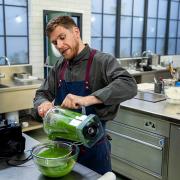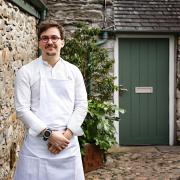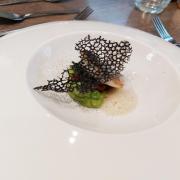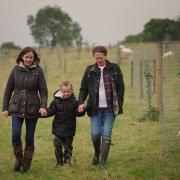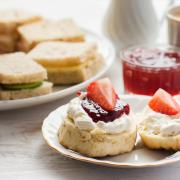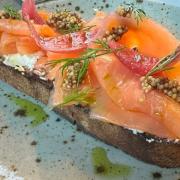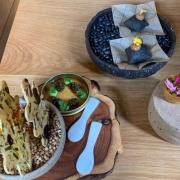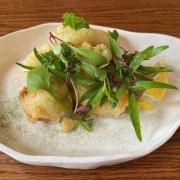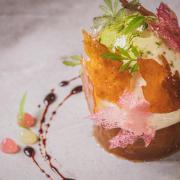Cookery editor Philippa James overcomes her nerves to visit a Goosnargh gamekeeper
Philippa James goes Clay Pigeon shooting with Neil and Sharon Jones and some of the staff of Samlesbury Hall in Lancashire.
Plus Duck and Orange Casserole clip
Although brought up in the country, I was never part of the hunting, shooting and fishing fraternity so I will admit to a few nerves as I set off to meet gamekeeper Ian Banks at Eaves Green Game Farm, Goosnargh. Like many of us, I know where my food comes from, but I am less keen on thinking about its dispatch.
As Ian and I walked over to the hatching sheds, I asked the question that was concerning me the most: did the game birds suffer? Ian stopped, and as one of his gun dogs bounded around us, he explained that if a shot was a bad one, the quarry is rapidly retrieved and the end is swift; as he said: ‘The dogs ensure there is minimum suffering.’
As we progressed into the first shed, I saw a 60-year-old, ‘Turkeybator’, for incubating the eggs, pheasants or ducks - up to a maximum, during the spring, of 15,000 a week!
Ian explained that the eggs are placed in the trays pointed end down so the chicks can break out, through the fat, airspace end. There is a rota system, to prevent over-heating of the growing chicks, and, some three weeks later, the chicks are individually hand-counted into foam-lined trays to prevent their feet splaying.
‘They are like your little babies,’ he said - here is a man who cherishes every chick. ‘From here the day-old chicks go into the ‘sun parlours’, they’re gas-warmed cabins, and the more room they have to roam, the better.’
At all stages the birds have access to water, and, initially ‘crumb’ feed, later wheat. From the cabins the birds go into sheds with floors lined with recycled cardboard, then outside runs. The ducks go onto ponds, where Ian explained that only 50 per cent of them go to the shoot, the rest find their way onto our canals, reservoirs and so forth. Likewise, with the pheasants, only around 40 per cent are killed on a shoot. Ian explained that the process is truly ‘free range’, and very conservation-minded.
The enormity of the whole operation is staggering; Ian, and his team, rear up to 30,000 pheasants, and around 6,000 ducks a year and he also buys game back, from other shoots.
As we walked around some of the runs I asked why there were some white ducks and pheasants. Apparently the first of the ‘guns’ to shoot a white bird is supposed to make a payment to the gamekeeper, or the person who shoots the bird is given �5 by everyone else on the shoot.
The regionality of Ian’s customers is important to him; his main outlets are Nigel Haworth of Ribble Valley Inns, Furness Fish, Lakeland Speciality Foods, and Altham’s Butchers. Ian also noted that, since Lisa Allen, Head Chef at Nigel’s Northcote, won on The Great British Menu, the demand for rabbit has gone through the roof.
I have met many producers who are passionate about their subject butas Ian talked of how he came to his vocation I caught a glimpse of his compassionate nature.
Ian’s father Brian used to ‘rough’ shoot birds and rabbits from the hedgerows as a hobby, rearing pheasants and ducks under broody hens. Ian loved going out shooting, with his dad, and, around the age of 14, Ian stayed on the highly successful Bleasdale Estate, where he realised gamekeeping was his true love.
Ian ended up turning away from his grandfather’s jewellery business, George Banks, in Preston, and instead went to work on the Abbeystead Estate, for the Duke of Westminster.
Ian explained that pigeons can be an absolute menace to crops, destroying wheat, peas and maize and when we arrived at another cabin Ian showed me ‘The Bingham Poultry Plucker’ (yes, really!)
In seconds he had produced a beautifully prepared pigeon, then, using a process which looked more like it came from a beautician’s than a processing plant, he explained that the pens (quills) which remain can be removed by dipping the bird into first a bath of hot wax, then cold water.The entrails are removed, and the birds are placed into trays; although Ian doesn’t have a shop, customers are welcome to call at the farm, Monday to Friday from 8am-5pm.
Ian then took me to meet his 85-year-old mum Margaret, nicknamed Bunty, and over coffee we tucked into her gorgeous Millionaires’ Shortbread.
It was interesting to hear that as well as the day’s shooting packages Ian offers, he can also accommodate people with disabilities, where they can participate, sitting on quad bikes; no-one is excluded from joining in, and sharing Ian’s passion for gamekeeping.
Duck and Orange Casserole
For four people - you need the meat from two cooked ducks, try not to break it up, too much. I make my stock by boiling the carcasses in water, for about 45 minutes, in a covered pan.
Ingredients
These are my choice of vegetables; you can omit, or add your own preferences, although go carefully if you use parsnip, as it has a distinctive flavour.
4 small or 2 large carrots8 - 12 small, salad, or waxy type potatoes, like Charlotte2 per person or 1 standard turnip, baby ones if you can get them 1 small swede1-2 celery sticks 2 sweet potatoes1 small butternut squash1 medium onion1 medium leekA few sprigs of parsley, choppedSalt and black pepper, to tasteZest of a quarter of one orange Small splash CointreauSunflower or vegetable oil
Dumplings
Makes 8100g/4oz self-raising flour50g/2oz suetA pinch of saltA generous pinch of dried mixed herbsA few sprigs of fresh parsley, choppedCold waterMix all the dry ingredients together, then add enough water to make a soft dough.
Method
1. Prepare the vegetables, and chop into roughly the same sized chunks.
2. Into a large pan, drizzle some oil, and put onto a low to medium heat.
3. Starting with the firmer vegetables, as listed, above, cook these for about 10 minutes, then carry on adding the softer ones, stirring to prevent them sticking, cook all together for another 20 minutes.
4. Add the duck pieces, and enough stock, or water, (You could add half a chicken stock cube) to just cover. Turn onto a low heat.
5. Add the parsley, seasoning, orange zest, and, if using, a splash of Cointreau, or juice from the orange. Cook, gently, and with minimal stirring, for a further 10 minutes, with the lid on, until the duck is hot through, and the vegetables are cooked.
6. Pop the dumplings gently onto the top of the simmering casserole, replace the lid, and cook, for 10-15 minutes, until the dumplings are light, fluffy, and twice the size they started out!



